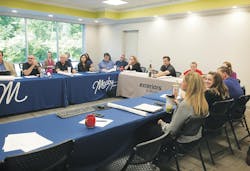Looking Towards the Future
It was at last year’s Extreme Sales Summit that I first decided to start Mosby’s Futures Committee. One of the speakers—I don’t remember who—said, “If I were a business owner, I’d have a committee whose sole focus would be the future of the industry and what will affect it.” I took his advice.
The start of the committee was as easy as deciding the who, why, when, and how of it all—questions that mostly answered themselves.
Who? Any employee interested in the future of the industry, and who wants to contribute to our success.
Why? To prepare Mosby for the future, to seek out and understand forthcoming disruptors—and big ones, too, not just new products. We want to be able to see how the remodeling landscape is shifting before we get lost in that shift. Some of the things we’ve talked about already are Tesla’s Powerwall and how it will change the home completely; the unique buying and selling habits of Millennials; and robotics—things like exoskeletons and AI.
When? Our meetings began this past January. We anticipate having a handful of meetings throughout the year (and indefinitely beyond that). The cadence of each meeting is determined by the topics’ urgency, relevance, agreed upon deadlines, etc. We’re still ironing out what works best.
How? Answering this question required the most thought. Mosby has about 90 employees, and when we pitched committee participation, we were surprised that over a quarter of them stepped up. That’s a lot of brains in one room. To make sure they were engaged and focused, we decided the best way to organize them would be by interest and disruptor type.
If you dig enough, you’ll find that even though remodeling is a fragmented industry that’s traditionally slow to adopt technology, it’s still filled with opportunity for disruption. With that in mind, we decided to chop potential disruptors into types: consumer-facing technology, product technology, business technology, building technology, consumer buying trends, demographic shifts, labor trends, and human resource trends, among others. Employees chose which topics they were most interested in researching, and we gave them some homework (i.e., “go find what’s coming down the pike”). When they have something to report, they present it at the meeting. The topics not only work to help organize our discussions, but they also give staff a chance to explore an existing interest—which we hope will lead to an increased interest in the industry as well as in the future of Mosby.
The main benefit of the committee is the ability to better maneuver in an industry that is rapidly changing. But something I’ve already noticed in the few meetings we’ve had is that the committee is also an effective way to identify future leaders. It gives employees, who may have never otherwise had an impetus to speak, a welcoming platform on which to show their capabilities.
It’s only been a few months, but they’re already surprising me.

